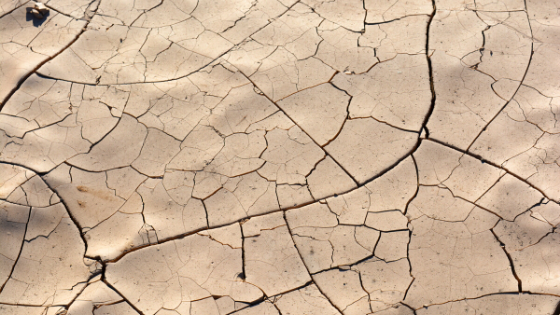
How to Keep Your Landscape Lush During Drought

The past few have been landmark years for drought across the United States. With record-breaking dryness, people are struggling just to keep their grass green, not to mention planting a lush flower bed.
With up to 22.5 percent of the United States experiencing drought in 2017 and only a slight decrease this year—water shortages are starting to have a long-term effect on landscaping in both commercial and residential settings. Sprinklers seem to be a luxury now. In states like California, where water restrictions keep being extended, keeping grass green is just the beginning.
So, how do you maintain the beautiful, lush, green landscaping during severe drought?
1. Know your climate
The more you know about your climate, the better-prepared you’ll be to handle any situation—drought, storms, flooding, heat waves, etc.
The National Oceanic and Atmospheric Administration’s (NOAA) Center for Environmental Information provides amazingly comprehensive information. On its site, you can stay up-to-date on state- and nation-wide trends that will affect your landscaping. Check out their State of the Climate Reports so you know what to expect from the environment in the area where you live.
Another great resource is the US Geological Survey’s Drought Watch gives your real-time maps to see how drought is affecting your neighborhood. There are maps, graphs and tables with current and past streamflow conditions, water elevation facts and information about floods, runoff and precipitation. If you’re into understanding the climate—this is your place!
2. Use Smart Watering Techniques
Watering is not a basic task, especially during a drought, when water is a precious commodity.
In places with extreme climates, like Israel—where landscapers have developed a host of inventive ways to water plants—hydrating the soil becomes a complex task. Luckily, you can borrow some of these techniques for your own property.
Some of the best options are: soaker hoses, drip irrigation, sectioning, and deep watering.
Soaker hoses lay alongside rows or garden beds to water slowly and consistently, keeping plants thriving without wasting water. To keep the hose safe, cover it with mulch and take it up during freezing winter weather months.
Drip irrigation runs a separate hose tube to each bed or plant. While it can be time-consuming to set up, drip irrigation delivers water to exactly where you need it. This way, your precious plants and greenery stays alive and thriving, and you don’t waste water on dirt or mulch areas.
Like drip irrigation, sectioning delivers water where it’s most necessary. Some plants will need more water than others. This can depend on everything from sun exposure to height, depth of the soil or simply seasonal growth. Have separate watering systems for drought-resistant plants and then plants that require more water (ones in sunny spots, with shallow roots or less absorbent soil). Controlling how much water each plant gets will stop you from over-watering the resilient ones without depleting the thirsty plants.
Finally, deep watering makes the water go way down into the soil so that plants will grow roots further down. Shallow watering, where you water a bit each day, means that moisture only stays on the surface. Plants will only grow shallow roots, making it harder for them to get the water naturally occuring deep in the soil. It can be better to water deeply—for a longer period of time, but less frequently. Soaker hoses and drip watering help with this. It’s easier to water deeply with a system, rather than standing with a hose!
3. Collect runoff
Build a water-collection system to catch any rain that does come.
Rain barrels are one popular way to get runoff. Your can buy barrels made for this purpose, with spouts and funnels, or use just about any large containers available. Have your landscapers install these under gutter spouts or anywhere where water runs off a building or structure. If bugs or litter become an issue, you can place screens over the barrels to filter these out.
Saving precipitation to re-use when your landscaping needs it most is one of the most environmentally-friendly ways to keep your garden lush during drought.
4. Mulch and compost for healthy soil
Healthy soil will hold moisture longer and deliver it to plants better. It all starts at the foundation!
One way to give your soil a helping hand is mulch. Adding a 2 or 3-inch layer of pine straw or mulch around plants creates a protective barrier between the harsh, dry air and the soil. This keeps your plants from drying out so quickly and stops fast evaporation from stealing water out of the garden beds or planters. You can use alternatives like newspaper, compost, or store-bought mulch—there are a lot of options for safe barriers.
Ultimately, the health of your landscaping comes down to the soil. Sandy soil does not hold water well. Clay soil holds water but gets rock hard when it dries. The solution for most types of soil is compost. Adding compost, which is light, soaks up moisture and holds water well will improve water retention in almost any soil. To get compost, you can create it yourself or buy bagged mushroom compost or excess from a local farm.
Ask a professional about soil types, mulch and compost options to make your garden grow. Using all of these resources to safeguard your landscaping against persistent drought will save you time, money and stress in the long run.
The Best Times to Plant Trees in Cold and Warm Climates
Links:
https://www.houselogic.com/by-room/yard-patio/best-time-to-plant-trees/
https://www.gardenmyths.com/best-time-planting-trees/
https://www.thespruce.com/when-to-plant-trees-2132841
